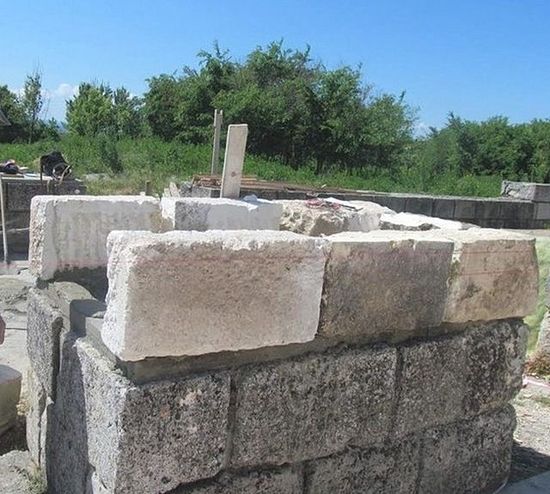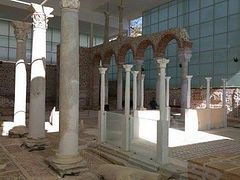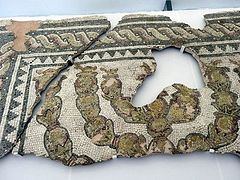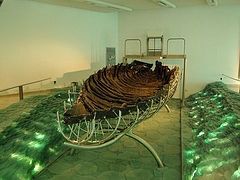Source: Archaeology in Bulgaria
June 1, 2016
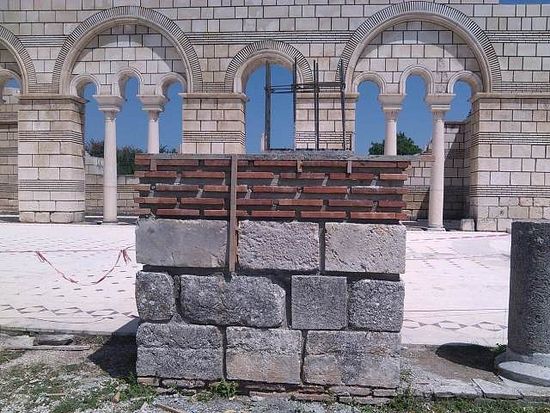 The most recent photo of the restoration works of the Great Basilica in Pliska released by the National Museum of History in Sofia as of June 1, 2016. Photo: National Museum of History
The most recent photo of the restoration works of the Great Basilica in Pliska released by the National Museum of History in Sofia as of June 1, 2016. Photo: National Museum of History
The archaeological restoration of the 9th century Great Basilica in Pliska, capital of the First Bulgarian Empire (632/680-1018 AD) between 680 and 893 AD, has been re-intensified by the National Museum of History in Sofia as of May 2016.
This has been made clear in a statement of the Museum which has also renewed its call for donations for the restoration works (find the bank account for donations is at the end of this article).
In March 2016, Bulgaria’s Cabinet allocated a total of BGN 770,000 (app. EUR 335,000) to the Ministry of Culture for completing the archaeological of the 9th century Great Basilica in the capital of the First Bulgarian Empire (632/680-1018 AD) Pliska, after having already allocated BGN 500,000 (app. EUR 250,000) in the summer of 2015.
The restoration of the Great Basilica in Pliska, which was the largest church in Europe until the 16th century, was started by Bulgaria’s National Museum of History in November 2015. It was initiated after the 1150thanniversary since Bulgaria’s adoption of Christianity as the official state religion.
At one point, the management of the National Museum of History had intended to complete the restoration, which is being funded with both government money and private donations, by May 2, the Day of St. Knyaz (King) Boris I Mihail (r. 852-889; 893) who turned the First Bulgarian Empire into a Christian state in 864-865 AD. However, these intentions have failed to materialize.
Nonetheless, on May 2, 2016, Bulgaria marked the 1151th anniversary since its formal adoption of Christianity with celebrations in Pliska, today a small town in the northeastern part of the country, in the Shumen District.
In its latest statement on the ongoing restoration of the Great Basilica in Pliska, the National Museum of History has announced it has received a donation of 3,000 square meters worth of stone pavement for the floor of the temple by Rumen Ralchev, head of the Order of Knights Templar in Bulgaria.
The Museum also says it keeps receiving numerous requests for wedding and baptism ceremonies to be held amidst the ruins of the Great Basilica, and has urged those wishing to hold such ceremonies there to contact the local representative of the Bulgarian Orthodox Church in the town of Pliska, Father Andrey.
The Great Basilica in Pliska was built between 865 and 875 AD, under Knyaz Boris I, after the First Bulgarian Empire adopted Christianity. It was constructed using huge rectangular limestone blocks (“quadras"). Each of these blocks weighed 300-400 kg, and each of them was processed individually to produce rectangular cuboids.
The Great Basilica in Pliska, the first capital of the First Bulgarian Empire (632/680-1018 AD) south of the Danube, was destroyed by the Ottoman Turks at the end of the 14th century even though part of its ruins are known to have survived until the 1860s when the Ottoman Empire built its first railway connecting the Bulgarian cities of Varna on the Black Sea, and Ruse on the Danube.
The Ottoman authorities are known to have used construction materials from the basilica and other marvelous Bulgarian archaeological monuments in Pliska and VelikiPreslav, another early medieval Bulgarian capital, not only for railway construction but also for building military barracks and mosques.
The Museum has been granted permission by the Bulgarian Transport Ministry to collect original construction materials from the basilica and other monuments found lying around the train station in Northeast Bulgaria in order to reintegrate it into the building.
A more controversial solution has been destruction of a couple of defunct 19th century train stations in order to extract the original materials for the restoration of the temple. The Museum and its Director Bozhidar Dimitrov, the chief proponent of the restoration, have been criticized for this with the argument that they are destroying other cultural monuments (the Ottoman-built train stations).
In a separate report on the restoration which has come out the same day as the latest Museum statement, the Bulgarian daily Trud reports that over 100 cubic meters of Pliska stones have already been transferred from the Bulgarian State Railways to the site of the Great Basilica.
In addition to using a method called “anestilosis", i.e. reusing surviving original materials from the Great Basilica for its reconstruction, the restorers are also putting in newly made stone blocs from a quarry near the town of Mezdra in Northwest Bulgaria.
“We have everything necessary, old and new alike, to build up the Basilica," Bozhidar Dimitrov, Director of the National Museum of History, is quoted as saying.
The restoration is being executed under a project from the 1980s authored by architect Teofil Teofilov (1944-2008), an expert in the architectural restorations of archaeological monuments. The project has been updated by architect Yiliy Farkov who has worked on some of Bulgaria’s recent controversial restorations.
Farkov is now reported to be working on a project for the restoration of the temple’s so called holy well, i.e. the sacred spring, also known with the Greek word “ayazmo" (a spring or a small body of water revered by pagans and/or Christians) which was rediscovered during the 2015 excavations led by Assoc. Prof. Pavel Georgiev from the Shumen Branch Office of the National Institute and Museum of Archaeology in Sofia.
It is reported that since the start of the efforts for the restoration of the Great Basilica, the once early medieval Bulgarian capital Pliska has seen a boom of visitors, with a total of 54,500 tourists visiting in 2015, up from fewer than 30,000 in 2014.
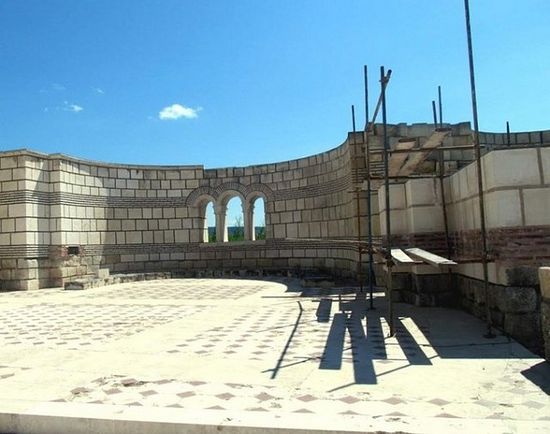 Recent photos of the restoration of the Great Basilica in Pliska by the Trud daily, as of June 1, 2016. Photos: Trud daily
Recent photos of the restoration of the Great Basilica in Pliska by the Trud daily, as of June 1, 2016. Photos: Trud daily
Donations for the restoration of the Great Basilica in Pliska can be made to the bank account of the Pliska Association which is chaired by Dimitrov and raises money for archaeological restorations in Bulgaria’s medieval capitals:
Pliska Association
Eurobank EFG Bulgaria
Branch Sofia
IBAN: BG47 BPBI 7939 1087 7828 01
BIC: BPBIBGSE
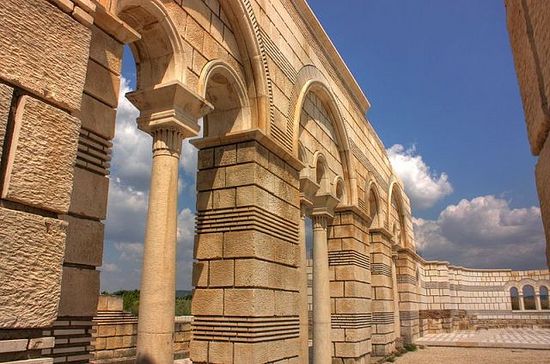 This 2008 photo shows the surviving and partially restored (during earlier restorations) ruins of the Great Basilica in Pliska. Photo: Klearchos Kapoutsis, Wikipedia
This 2008 photo shows the surviving and partially restored (during earlier restorations) ruins of the Great Basilica in Pliska. Photo: Klearchos Kapoutsis, Wikipedia
Background Infonotes:
Pliska and Veliki Preslav (Great Preslav) are two of the capitals of the First Bulgarian Empire. Pliska was the capital of the First Bulgarian Empire in 680-893 AD, and Veliki Preslav in 893-970 AD, at the height of the Bulgarian state. The state capital was moved from Pliska to Veliki Preslav, a new medieval city nearby, in 893 AD in order to seal Bulgaria’s adoption of Christianity and the Bulgarian (Slavic, Cyrillic) script (in 865 and 886 AD, respectively). The ruins of both Pliska and Veliki Preslav can be seen today in the Shumen District in Northeast Bulgaria.
***
The Great Basilica “St. Sofia" in the city of Pliska, capital of the First Bulgarian Empire between 680 and 893 AD, was built between 866 and 875 AD, after Bulgaria’s adoption of Christianity as the official state religions in 865 AD under Knyaz Boris I Mihail (r. 852-889; 893 AD).
The Great Basilica in Pliska, the first capital of Bulgaria south of the Danube, was the largest Christian cathedral in Europe in the Middle Ages. It was 102.5 meters long and 30 meters wide, which means it was 20 meters longer than the Hagia Sophia Cathedral in Constantinople, the titular temple of the Ecumenical Patriarchate during the period of the Byzantine Empire, and about 30 meters longer than the Old St. Peter’s Basilica in Rome (the predecessor of today’s St. Peter’s Cathedral). Thus, the Great Basilica in Bulgaria’s Pliska was technically the largest Christian temple in Europe until the 17th century, i.e. until the completion of the Papal Basilica of St. Peter in the Vatican in 1629 AD.
The Great Basilica in Pliska was built with huge white limestone quadras from the quarries in the nearby town of Kyulevcha. Around the basilica there was a large monastery complex and the residence of the Bulgarian Archbishop (between 870 and 917 AD), and the Bulgarian Patriarch (from 917 AD onwards). In this monastery complex, Bulgarian archaeologists have found a scriptorium for the “production" of medieval books in Old Bulgarian, also known as Church Slavonic. As Bulgaria’s National Museum of History points out, “it is with these books that the monastery monks and missionaries converted [to Christianity] the peoples of modern-day countries Russia, Ukraine, Belarus, Romania, Moldova, Serbia in the 9th-10th century."
The Great Basilica in Pliska was still standing until the Late Middle Ages but was razed to the ground by the Ottoman Turks after their invasion at the end of the 14th century, and in the 15th century, because according to the laws of the Islamic Ottoman Empire no Christian temple could stand taller than a Muslim man mounted on a horse. The construction material from the unique buildings in Pliska was used by the Ottomans for the construction of the Turkish military barracks and the Tombul Mosque in the nearby city of Shumen, and whatever had been left of it by the 19th century – for the construction of the Varna-Ruse railway in 1866 under Ottoman governor Midhat Pasha.
***
Bulgaria’s adoption of Christianity as the formal and only state religion took place in 864-865 AD under the leadership of Khan / Knyaz Boris I Mihail (r. 852-889; 893 AD).
As a result of the successful reigns of Khan (or Kanas) Krum (r. 803-814 AD), Khan (Kanas) Omurtag (r. 814-831 AD), Khan (Kanas) Malamir (r. 831-836), and Khan (Kanas) Presian (r. 836-852 AD), by the middle of the 9thcentury the First Bulgarian Empire had become a huge empire spanning from the Black Sea in the east to the Adriatic Sea in the west, and from the Northern Carpathian Mountains in the north to the Aegean Sea in the south, including the entire or part of the territory of modern-day Bulgaria, Romania, Serbia, Greece, Turkey, Albania, Macedonia, Hungary, Moldova, and Ukraine. However, the major peoples inhabiting the Bulgarian Empire – the Ancient Bulgars (whose religion is known as tengriism) and the Slavs as well as the local Thracian population and others – worshipped different gods according to their own religions and mythologies. This was true even though there were entire areas in the then Bulgarian Empire which had been Christianized in earlier periods, and even though the first Khans from the House of Dulo are believed to have been Christians who were baptized by the imperial court of the Eastern Roman Empire, i.e. Byzantium: Khan (Kanas) Kubrat (r. ca. 630-ca.660) who founded the so called Old Great Bulgaria in 632 AD on the territory of much of modern-day Ukraine and Southwest Russia; Khan (Kanas) Asparuh (r. ca. 680-700) who expanded the state to the southwest technically creating modern-day Danube Bulgaria around 680 AD; and Khan (Kanas) Tervel (r. 700-718/721)who saved Europe from an Arab invasion during the siege of Constantinople in 717 AD. This led Khan Boris I to decide to unite the different ethnicities in the First Bulgarian Empire with a new common religion, and to pick Christianity (even though the adoption of Islam and Judaism were also offered to him by foreign emissaries) because Bulgaria was then the only still pagan major European power, and he wanted Bulgaria to be treated as an equal by the Byzantine Empire in the east and the successors of the Frankish Empire in the west.
While Khan Boris I initially intended to adopt the Western form of Christianity from the Pope in Rome via the Kingdom of the East Franks (East Francia in modern-day Germany) because Byzantium had been Bulgaria’s major geopolitical foe, he was forced to change his decision after an unsuccessful war with the Byzantines imposed on him the adoption of the Eastern form of Christianity as part of a peace treaty signed in 863 AD. This resulted after the First Bulgarian Empire had had to fight simultaneously Byzantium in the southeast and Great Moravia in the northwest. Thus, in 863 or 864 AD, a mission from the Patriarch of Constantinople Photios came to Pliska and converted the Bulgarian Tsar, his family and high-ranking dignitaries, who were baptized as Christians. Khan Boris I became Knyaz Boris I Mihael – taking the name of his baptist, Byzantine Emperor Michael III (r. 842-867 AD), and in 865 AD there was baptism en masse of the entire Bulgarian population. Thus, even though the subsequent years saw the first major clashes between the Pope in Rome and the Ecumenical Patriarch in Constantinople over the “Bulgarian Question", i.e. whose diocese the large and powerful newly baptized First Bulgarian Empire should belong to, Bulgaria remained in the camp of Eastern Orthodox Christianity subsequently helping pass it on to later emerging nations such as Serbia and Russia, and thus modifying forever the history of Europe.
Bulgaria’s adoption of Christianity, however, went far from smoothly, and not only because of the clashes between the Pope in Rome and the Ecumenical Patriarch in Constantinople over whose diocese the newly converted Bulgarians should belong to. In 865, conservative Bulgar aristocrats from all 10 komitats (administrative regions) of the First Bulgarian Empire revolted against Boris, who now took the Christianized title of Knyaz (i.e. King) in order to restore the old religion, tengriism. Knyaz Boris I managed to suppress the revolt executing 52 Bulgarian boyars (heads of noble families). According to some sources, he also had their entire extended families executed. Until the end of his life, Knyaz Boris was haunted by guilt about the harshness of his measures and the moral price of his decision in 865. In his later correspondence with Pope Nicholas I, the Knyaz asked whether his actions had crossed the borders of Christian humility, for which the Pope offered forgiveness: “You have sinned rather because of zeal and lack of knowledge, than because of other vice. You receive forgiveness and grace and the benevolence of Christ, since penance has followed on your behalf."
Knyaz Boris realized that the Christianization of Bulgaria gave Byzantium great influence over the domestic affairs of the Bulgarian Empire. Thus, juggling the differences of Rome and Constantinople, he eventually managed to get Byzantium’s Ecumenical Patriarchate as well as the Pope in Rome to recognize an independent (autocephalous) Bulgarian Archbishopric, which was created in 870 AD in an unprecedented development for Europe because independent churches had been only those founded by Apostles or Apostles’ disciples. For example, the Papacy in Rome had been challenging Constantinople’s claim of equality to Rome on the grounds that the Church of Constantinople had not been founded by an Apostle of Jesus Christ. Nonetheless, this development was also a success for Byzantium, and during the decade after 870 AD, Pope Adrian II and his successors kept trying desperately to convince Bulgaria’s Knyaz Boris to leave Constantinople’s religious sphere.
Knyaz Boris I Mihail sealed the success of his deed, the adoption of Christianity, in 886 AD when Bulgaria welcomed the disciples of St. Cyril and St. Methodius, St. Kliment Ohridski and St. Naum Preslavski, helping them to teach thousands of Bulgarian clergymen to serve in Bulgarian. Thus, Bulgaria adopted the Bulgarian script, also known as the Slavic script – first the Glagolithic and then the Bulgarian (Cyrillic) alphabet. This allowed Knyaz Boris, and his successor Tsar Simeon I the Great to declare Bulgarian (also known as Old Bulgarian or Church Slavonic) as the official language of the Bulgarian Orthodox Church during the Council of Preslav in 893 AD (which also moved Bulgaria’s capital from Pliska to Veliki Preslav (Great Preslav). As all over Europe religious services were held in the “official" church languages Latin and Greek, this “nationalization" of the liturgy language by Bulgaria became another exceptional development in medieval Europe after the recognition of the independent Bulgarian church.

